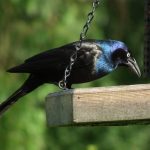For a creature that has been extinct for almost 100 million years, Microraptor certainly seems to love the spotlight. This over-achiever doesn’t just have two wings like most other feathered vertebrates, it has four. The better to show off its glorious black iridescent feather, I suppose. And now it’s on record for “most diverse diet found in the fossil record.” That’s right, scientists found fossil evidence of multiple Microraptors’ last meals, which included fish, birds, smaller dinosaurs, and now, even mammals.

It’s extremely rare for paleontologists to find the gut contents of dinosaurs or other animals in the fossil record. This is because once an animal or plant is eaten, it starts to get digested which gets in the way of preservation. The softer a material is, the less likely it is to be fossilized. This is why things like internal organs are so very rare to find as fossils. Even when gut contents are found, because the animals often chew their food, things get mixed and mashed up, making it almost impossible to tell one thing from another. Once an animal dies, scavengers will often have their own meals, scattering the remains and making it even harder to find and identify specific things. But paleontologists in China have discovered fossils of several Microraptors’ last meals preserved inside their fossilized skeletons. Not only that, but scientists were able to discern what types of animals these remains came from. The most recent discovery was possibly the most important, however, changing the way we look at Microraptor and its eating behaviors. A few weeks ago, a paper was published describing a Microraptor fossil that contained the skeletal foot of a small mammal in its gut. Not only that, but they were able to tell by the curvature of its foot that this mammal was not a tree-dweller. Before this, scientists thought Microraptor hunted by swooping and soaring to reach its prey among trees. Now, we have evidence that this winged dinosaur ate lizards, birds, fish, and mammals, giving it possibly the most diverse diet we have evidence for among the dinosaurs and revising our understanding of how it got its food.

Microraptor is a small, feathered dinosaur that had what are called “pennaceous feathers,” the feathers commonly associated with birds’ wings and tails, on both its arms and legs, effectively giving it four wings. By looking at fossilized bacteria and melanosomes, or pigment cells, present in these feathers, scientists can tell that Microraptor would have been covered with glossy, iridescent black feathers, much like a common grackle today. It had an elongated snout, which may hold the key to figuring out what it and other dinosaurs ate as well.
As a general rule, animals who hunt small, faster moving prey tend to have longer, narrower snouts and jaws than their counterparts who hunt large prey, who tend to have shorter jaws. Scientists think this is because a pointier, longer snout allows for a greater reach, which is a benefit when hunting small and fast prey. A longer jaw, while having less of a bite force per tooth, makes for a faster bite, which is more important when hunting smaller prey. Because scientists have found four different fossils of Microraptors’ last meals and all four of these samples were of animals considerably smaller than the longer-snouted theropod hunter, we can begin to apply the same rule to animals that lived over 70 million years ago as we do to animals that live now. We can’t know for sure, of course, that Microraptor hunted these creatures. It might have been a scavenger or got its meals another way. But finding evidence of this theropod’s diverse diet adds one more piece to the puzzle of Cretaceous life.

“That tells us something about this animal and, by extension, tells us that there were generalist carnivores in these ancient ecosystems—that that niche existed,” says Corwin Sullivan, an associate professor in the Department of Biological Sciences at the University of Alberta and one of the scientists involved in this discovery.
Animals that eat a diverse diet are called generalists. Raccoons, crows, and coyotes are examples of generalists that are alive today. These animals can survive in a great many places because they are able to adapt their diets easily, as opposed to specialist creatures like koalas and pandas that only eat one plant and therefore are limited to living where that plant grows. Now that we have seen evidence of Microraptor’s generalist diet, we can see why their fossils are one of the most prevalently found. There were a lot of them, because they were able to adjust to live in a lot of places.

“We’re slowly gathering pieces of information about these past ecosystems and the animals that inhabited them,” says Sullivan.
Knowing which dinosaurs might have eaten what, assuming shorter-snouted dinosaurs had a diet of larger prey, and longer-snouted ones had one of smaller prey, means that we can begin to get a clearer picture of the age of dinosaurs. We can learn more about ancient ecosystems, how mammals, dinosaurs, birds, and other animals behaved together.
The reason Microraptor is the subject of so much research lately is because we’ve been finding so many of them. This puts us in the unique position of possibly becoming experts on these dinosaurs, which in turn can help us learn more about others. This dinosaur may be an attention hog, but when Microraptors’ last meals offer us so much knowledge, I suppose its position in the limelight is well-deserved.



